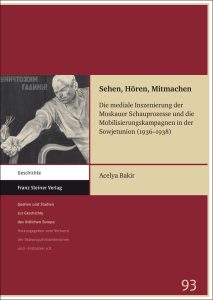Quelle: https://visual-history.de/2025/02/18/das-bildliche-in-recht-und-religionen/
Rezension: Acelya Bakir, Sehen, Hören, Mitmachen
Quelle: https://visual-history.de/2024/12/16/paul-rezension-bakir-sehen-hoeren-mitmachen/
CfP: In the Thick of Images: Law, History and the Visual
Screenshot: University of Lucerne [01.12.2023]
The ‘visual turn’ has long been turning in critical and cultural studies of law (see Douzinas & Nead 1999). In the past twenty-five years, a growing body of scholarship has evolved that emphasises law’s “constitutive imbrication” (Crawley 2020) with an array of visual forms, and elaborates on the ways in which images “shape and transform legal life” (Sarat et al. 2005).
Weaving together an eclectic set of theories, concepts, methods and materials, such studies refuse thin readings of images as merely illustrative of law, and invite us to think more deeply about their ideological and visual operations – about the meanings they carry and make available, about their material presence and affective effects, and about the cultural-political and cultural-legal work they perform across their multiple contexts of production, circulation and reception.
[...]
Quelle: https://visual-history.de/2023/12/01/cfp-in-the-thick-of-images-law-history-and-the-visual/
Wahlkampf in Brasilien: Ein Sieg für die politische Korruption?
Von Elizangela Valarini und Markus Pohlmann Man stelle sich vor: Ein aussichtsreicher deutscher Kanz...
Der NSU-Prozess: Eine Blöße des Rechtsstaates?
Von Markus Pohlmann Es ist eine Geduldsprobe für alle Beteiligten. Das Gericht hörte bislang circa 750 Zeugen und 56 Sachverständige. In dem bisher rund fünf Jahre andauernden Prozess wurden 248 Beweisanträge gestellt. Bis Juli 2017 wurden, der Geschäftsstelle des Gerichts zufolge, 33 Befangenheitsanträge gestellt, zumeist gegen die Richter selbst. Am 13. März 2018 war es dann wieder soweit – anstelle mit dem Plädoyer zu beginnen, stellten die Anwälte von Ralf Wohlleben einen Befangenheitsantrag gegen alle Richter des Strafsenats. Auch einige von Zschäpes Anwälten – … Der NSU-Prozess: Eine Blöße des Rechtsstaates? weiterlesen →


